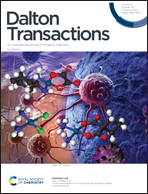Crystal-field induced tuning of luminescence properties of Na3GaxAl1−xF6:Cr3+ phosphors with good thermal stability for NIR LEDs†
Abstract
Cr3+-Activated broadband near-infrared (NIR) luminescence materials are attracting much attention as next-generation smart NIR light sources that are widely used in night vision, bioimaging, medical treatment, and many other fields. Herein, a series of Na3GaxAl1−xF6:Cr3+ NIR phosphors with broadband emission and tunable luminescence properties were designed and prepared. The luminescence intensity, peak position and full width at half maximum (FWHM) of the materials can be controlled by adjusting the crystal field strength. Furthermore, Na3Ga0.75Al0.25F6:0.35Cr3+ exhibited high luminous efficiency and the emission intensity remained 81% at 423 K compared with the initial value at 298 K. The structural confinement and the electron–phonon coupling (EPC) effect may account for its good thermal stability. Finally, a pc-NIR-LED device with a photoelectric conversion efficiency of 6.53% at 350 mA was fabricated by combining the as-prepared NIR phosphor and a blue InGaN chip, and its applications in night vision and medical fields were further investigated. This work will promote the development of NIR phosphors with tunable luminescence properties.



 Please wait while we load your content...
Please wait while we load your content...